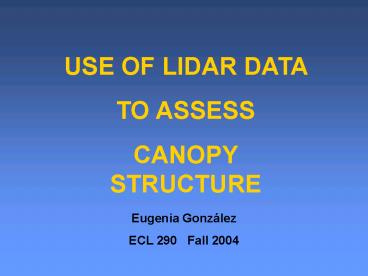USE OF LIDAR DATA - PowerPoint PPT Presentation
1 / 20
Title:
USE OF LIDAR DATA
Description:
Assess the potential of lidar data to initialize a height-structured ecosystem ... Lidar data of canopy height was effective to initialized an ED model ... – PowerPoint PPT presentation
Number of Views:439
Avg rating:3.0/5.0
Title: USE OF LIDAR DATA
1
USE OF LIDAR DATA TO ASSESS CANOPY STRUCTURE
Eugenia González ECL 290 Fall 2004
2
- OUTLINE
- Use of lidar data to characterize canopy
structure - Description of the technique
- Potential applications
- RS studies in Tropical Forests
- Example La Selva study
- Some caveats
3
Lidar (light detection and ranging)
- Active remote sensing technique
- Uses pulses of laser light (900-1064 nm)
- Measures the round-trip for a pulse to travel
between the sensor and the target - Provides a range (distance) between the
instrument and the object
4
Conceptual basis of operation
5
Two types 1. Discrete-return lidar 2.
Waveform-recording
6
Applications for vegetation studies
- Provide data on the vertical distribution of
intercepted surfaces ? Aboveground biomass
estimates ? Carbon studies - Spatial pattern of canopy height and cover
- Derived metrics stem diameter, basal area, mean
DBH - Metrics from lidar sensitive to different
land-use histories
7
Two general problems
- Exact elevation of ground surface may be
difficult to estimate if understory is dense
enough to occlude ground surface - Height of the canopy may be underestimated if
the top portion of the crowns do not have
sufficient area to register a return signal
8
Some Priority Research Goals for RS in
Tropical Forests
- Identification and characterization of secondary
forests - Documentation of the rate and extent of
deforestation
9
Why are RS studies so difficult in the tropics?
- Frequent overcast conditions
- Different stages of regrowth are hard to
discriminate
- Dry tropics deciduousness vary with climatic
conditions and successional status - Rapid saturation of common indices
10
La Selva Biological Station study
- Northeastern Costa Rica, 30-150 m elevation
- Tropical Wet Forest
- Mixture of forest plantations, secondary and
old-growth patches
11
La Selva Biological Station study
OBJECTIVE Assess the potential of lidar data to
initialize a height-structured ecosystem model
(ED) to estimate carbon stocks and fluxes
METHODS Lidar data (LVIS) collected at 8 km of
altitud, footprint size of 25 m diameter. Total
swath width of 1 km
12
METHODS
13
RESULTS
Distribution of mean canopy heights measured by
LVIS from areas with different land-use histories
14
RESULTS (cont)
Good agreement between field, regression and ED
estimates
up to a mean canopy height of 29 m
15
RESULTS (cont)
Estimates of aboveground Carbon stocks
16
RESULTS (cont)
Estimates of mean aboveground Carbon flux
17
From a related study
Detailed landscape pattern in ABG biomass
18
CONCLUSIONS
- Lidar data of canopy height was effective to
initialized an ED model - Better estimates for Carbon stocks and fluxes
since the structure represents actual
successional state of forest, not only potential
vegetation - Important constraint on model estimates
19
References
- Drake JB, RO Dubayah, DB Clark, RG Knox, JB
Blair, MA Hofton, RL Chazdon, JF Weishampel, SD
Prince. 2002. Estimation of tropical forest
structural characteristics using large-footprint
lidar. Remote Sensing of Environment 79 305-319. - Hurtt GC, RO Dubayah, J Drake, PR Moorcroft, SW
Pacala, JB Blair, MG Fearon. 2004. Beyond
pontential vegetation Combining lidar data and a
height structured model for Carbon studies.
Ecological Applications 14 873-883. - Lefsky MA, WB Cohen, GG Parker, DJ Harding. 2002.
Lidar remote sensing for ecosystem studies.
BioScience 52 19-30. - Mather PM. 2004. Computer Processing of
Remotely-Sensed Images. An introduction. 3rd
edition. John Wiley and Sons. West Sussex,
England. - Sánchez-Azofeifa GA, KL Castro, B Rivard, MR
Kalascka. 2003. Remote sensing priorities in
tropical dry forest environments. Biotropica 35
134-142.
20
Thank you!































